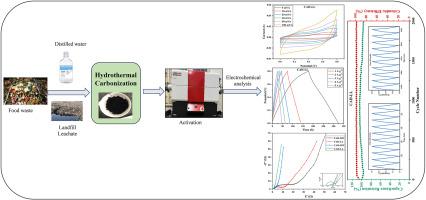Upcycling food waste into activated hydrochar: A sustainable and high-performance electrode material for supercapacitors
IF 7.7
2区 环境科学与生态学
Q1 ENVIRONMENTAL SCIENCES
引用次数: 0
Abstract
The transition towards sustainable energy sources necessitates advancements in energy storage technologies. This study addresses environmental concerns by transforming waste materials-specifically, using food waste (FW) as a precursor and landfill leachate (LL) as a moisture source in hydrothermal carbonization-to produce hydrochar. This hydrochar is subsequently activated and evaluated for its electrochemical performance. Thermal and chemical activation methods were employed to augment the surface properties of the hydrochar. Various characterization techniques, including CHNS, FESEM, FTIR, XRD, and BET, were utilized to comprehend the impact of the thermal and chemical activation on the morphology and physicochemical properties of the hydrochar. Electrochemical experiments were performed to evaluate the energy storage capabilities of the fabricated electrodes. The findings demonstrate that chemically activated hydrochar based electrodes exhibit superior electrochemical performance compared to thermally activated ones, showcasing nearly double specific capacitance values and enhanced cyclic stability. The symmetric cell based on chemically activated hydrochar demonstrates a specific capacitance of 362.5 F g−1, along with impressive cyclic stability. It retains approximately 95 % of its capacitance after 2000 cycles, with over 98 % coulombic efficiency maintained throughout. Additionally, this cell achieves energy density of 32 Wh/kg at 800 W/kg power density. This remarkable performance of chemically activated electrodes highlights the potential of activated hydrochar derived from food waste as a sustainable and high efficiency material for supercapacitor applications.

将食物垃圾升级为活化碳氢化合物:一种可持续的高性能超级电容器电极材料。
向可持续能源的过渡需要能源储存技术的进步。本研究解决了环境问题,通过转化废物-具体来说,利用食物垃圾(FW)作为前体和垃圾填埋场渗滤液(LL)作为水热碳化的水分来源-生产碳氢化合物。随后,该碳氢化合物被激活并评估其电化学性能。采用热活化法和化学活化法提高了烃类的表面性质。利用各种表征技术,包括CHNS、FESEM、FTIR、XRD和BET,来了解热活化和化学活化对烃类形态和物理化学性质的影响。通过电化学实验对制备的电极的储能性能进行了评价。研究结果表明,与热激活电极相比,化学活化的烃基电极具有优越的电化学性能,其比电容值几乎翻了一番,循环稳定性也得到了提高。基于化学活化的碳氢化合物的对称电池显示出362.5 F -1的比电容,以及令人印象深刻的循环稳定性。在2000次循环后,它保持了大约95%的电容,库仑效率保持在98%以上。此外,该电池在800 W/kg功率密度下实现了32 Wh/kg的能量密度。化学活化电极的这种卓越性能突出了从食物垃圾中提取的活化碳氢化合物作为超级电容器应用的可持续和高效材料的潜力。
本文章由计算机程序翻译,如有差异,请以英文原文为准。
求助全文
约1分钟内获得全文
求助全文
来源期刊

Environmental Research
环境科学-公共卫生、环境卫生与职业卫生
CiteScore
12.60
自引率
8.40%
发文量
2480
审稿时长
4.7 months
期刊介绍:
The Environmental Research journal presents a broad range of interdisciplinary research, focused on addressing worldwide environmental concerns and featuring innovative findings. Our publication strives to explore relevant anthropogenic issues across various environmental sectors, showcasing practical applications in real-life settings.
 求助内容:
求助内容: 应助结果提醒方式:
应助结果提醒方式:


